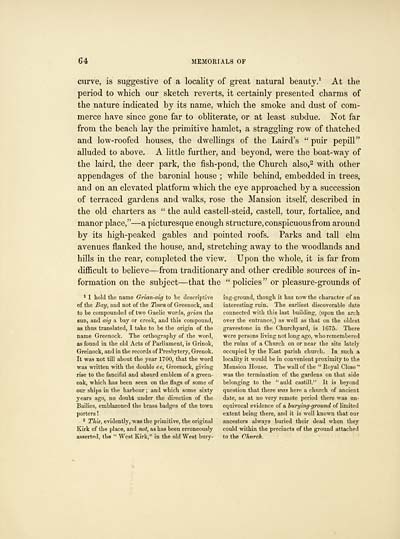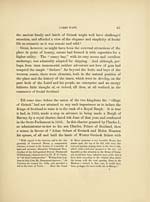Memorials of the lineage, early life, education and development of the genius of James Watt
(86) Page 64
Download files
Complete book:
Individual page:
Thumbnail gallery: Grid view | List view

64 MEMORIALS OF
curve, is suggestive of a locality of great natural beauty. 1 At the
period to which, our sketch reverts, it certainly presented charms of
the nature indicated by its name, which the smoke and dust of com-
merce have since gone far to obliterate, or at least subdue. Not far
from the beach lay the primitive hamlet, a straggling row of thatched
and low-roofed houses, the dwellings of the Laird's " puir pepill"
alluded to above. A little further, and beyond, were the boat-way of
the laird, the deer park, the fish-pond, the Church also, 2 with other
appendages of the baronial house ; while behind, embedded in trees,
and on an elevated platform which the eye approached by a succession
of terraced gardens and walks, rose the Mansion itself, described in
the old charters as " the auld castell-steid, castell, tour, fortalice, and
manor place," — -a picturesque enough structure, conspicuous from around
by its high-peaked gables and pointed roofs. Parks and tall elm
avenues flanked the house, and, stretching away to the woodlands and
hills in the rear, completed the view. Upon the whole, it is far from
difficult to believe — from traditionary and other credible sources of in-
formation on the subject — that the " policies" or pleasure-grounds of
1 I hold the name Grian-aig to he descriptive ing-ground, though it has now the character of an
of the Bay, and not of the Town of Greenock, and interesting ruin. The earliest discoverable date
to he compounded of two Gaelic words, grian the connected with this last building, (upon the arch
sun, and aig a bay or creek, and this compound, over the entrance,) as well as that on the oldest
as thus translated, I take to be the origin of the gravestone in the Churchyard, is 1675. There
name Greenock. The orthography of the word, were persons living not long ago, who remembered
as found in the old Acts of Parliament, is Grinok, the ruins of a Church on or near the site lately
Greinock, and in the records of Presbytery, Grenok. occupied by the East parish church. In such a
It was not till about the year 1700, that the word locality it would be in convenient proximity to the
was written with the double ee, Greenock, giving Mansion House. The wall of the " Koyal Close "
rise to the fanciful and absurd emblem of a green- was the termination of the gardens on that side
oak, which has been seen on the flags of some of belonging to the "auld castill." It is beyond
our shipB in the harbour ; and which some sixty question that there was here a church of ancient
years ago, no doubt under the direction of the date, as at no very remote period there was un-
Bailies, emblazoned the brass badges of the town equivocal evidence of a burying-ground of limited
porters ! extent being there, and it is well known that our
2 This, evidently, was the primitive, the original ancestors always buried their dead when they
Kirk of the place, and not, as has been erroneously could within the precincts of the ground attached
asserted, the " West Kirk," in the old West bury- to the Ohvrrh.
curve, is suggestive of a locality of great natural beauty. 1 At the
period to which, our sketch reverts, it certainly presented charms of
the nature indicated by its name, which the smoke and dust of com-
merce have since gone far to obliterate, or at least subdue. Not far
from the beach lay the primitive hamlet, a straggling row of thatched
and low-roofed houses, the dwellings of the Laird's " puir pepill"
alluded to above. A little further, and beyond, were the boat-way of
the laird, the deer park, the fish-pond, the Church also, 2 with other
appendages of the baronial house ; while behind, embedded in trees,
and on an elevated platform which the eye approached by a succession
of terraced gardens and walks, rose the Mansion itself, described in
the old charters as " the auld castell-steid, castell, tour, fortalice, and
manor place," — -a picturesque enough structure, conspicuous from around
by its high-peaked gables and pointed roofs. Parks and tall elm
avenues flanked the house, and, stretching away to the woodlands and
hills in the rear, completed the view. Upon the whole, it is far from
difficult to believe — from traditionary and other credible sources of in-
formation on the subject — that the " policies" or pleasure-grounds of
1 I hold the name Grian-aig to he descriptive ing-ground, though it has now the character of an
of the Bay, and not of the Town of Greenock, and interesting ruin. The earliest discoverable date
to he compounded of two Gaelic words, grian the connected with this last building, (upon the arch
sun, and aig a bay or creek, and this compound, over the entrance,) as well as that on the oldest
as thus translated, I take to be the origin of the gravestone in the Churchyard, is 1675. There
name Greenock. The orthography of the word, were persons living not long ago, who remembered
as found in the old Acts of Parliament, is Grinok, the ruins of a Church on or near the site lately
Greinock, and in the records of Presbytery, Grenok. occupied by the East parish church. In such a
It was not till about the year 1700, that the word locality it would be in convenient proximity to the
was written with the double ee, Greenock, giving Mansion House. The wall of the " Koyal Close "
rise to the fanciful and absurd emblem of a green- was the termination of the gardens on that side
oak, which has been seen on the flags of some of belonging to the "auld castill." It is beyond
our shipB in the harbour ; and which some sixty question that there was here a church of ancient
years ago, no doubt under the direction of the date, as at no very remote period there was un-
Bailies, emblazoned the brass badges of the town equivocal evidence of a burying-ground of limited
porters ! extent being there, and it is well known that our
2 This, evidently, was the primitive, the original ancestors always buried their dead when they
Kirk of the place, and not, as has been erroneously could within the precincts of the ground attached
asserted, the " West Kirk," in the old West bury- to the Ohvrrh.
Set display mode to:
![]() Universal Viewer |
Universal Viewer | ![]() Mirador |
Large image | Transcription
Mirador |
Large image | Transcription
Images and transcriptions on this page, including medium image downloads, may be used under the Creative Commons Attribution 4.0 International Licence unless otherwise stated. ![]()
| Histories of Scottish families > Memorials of the lineage, early life, education and development of the genius of James Watt > (86) Page 64 |
|---|
| Permanent URL | https://digital.nls.uk/95170486 |
|---|
| Description | A selection of almost 400 printed items relating to the history of Scottish families, mostly dating from the 19th and early 20th centuries. Includes memoirs, genealogies and clan histories, with a few produced by emigrant families. The earliest family history goes back to AD 916. |
|---|

